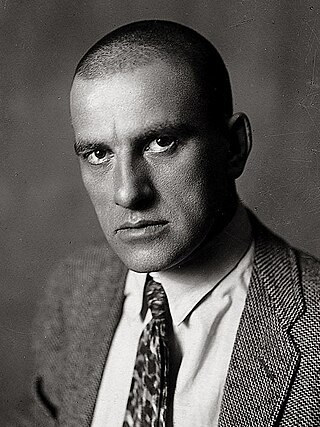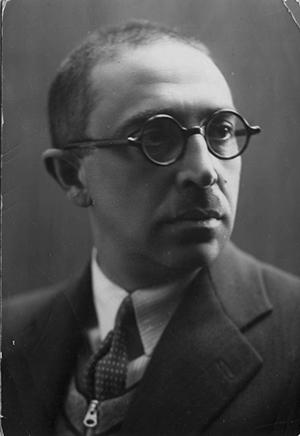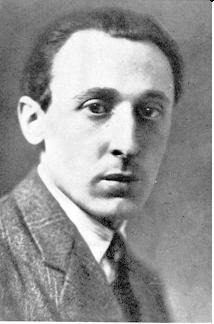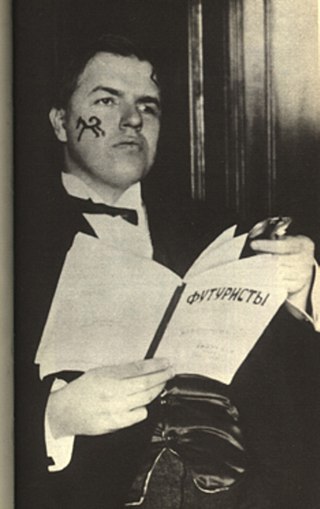Related Research Articles

Vladimir Vladimirovich Mayakovsky was a Russian poet, playwright, artist, and actor. During his early, pre-Revolution period leading into 1917, Mayakovsky became renowned as a prominent figure of the Russian Futurist movement. He co-signed the Futurist manifesto, A Slap in the Face of Public Taste (1913), and wrote such poems as "A Cloud in Trousers" (1915) and "Backbone Flute" (1916). Mayakovsky produced a large and diverse body of work during the course of his career: he wrote poems, wrote and directed plays, appeared in films, edited the art journal LEF, and produced agitprop posters in support of the Communist Party during the Russian Civil War of 1917–1922.

Futurism was an artistic and social movement that originated in Italy, and to a lesser extent in other countries, in the early 20th century. It emphasized dynamism, speed, technology, youth, violence, and objects such as the car, the airplane, and the industrial city. Its key figures included Italian artists Filippo Tommaso Marinetti, Umberto Boccioni, Carlo Carrà, Fortunato Depero, Gino Severini, Giacomo Balla, and Luigi Russolo. Italian Futurism glorified modernity and, according to its doctrine, "aimed to liberate Italy from the weight of its past." Important Futurist works included Marinetti's 1909 Manifesto of Futurism, Boccioni's 1913 sculpture Unique Forms of Continuity in Space, Balla's 1913–1914 painting Abstract Speed + Sound, and Russolo's The Art of Noises (1913).

Osip Maksimovich Brik was a Russian avant garde writer and literary critic, who was one of the most important members of the Russian formalist school, though he also identified himself as one of the Futurists.

Rayonism was a style of abstract art that developed in Russia in 1910–1914. Founded and named by Russian Cubo-Futurists Mikhail Larionov and Natalia Goncharova, it was one of Russia's first abstract art movements.

Bruno Jasieńskipronounced[ˈbrunɔjaˈɕeɲskʲi], born Wiktor Bruno Zysman, was a Polish poet, novelist, playwright, Catastrophist, and leader of the Polish Futurist movement in the interwar period. Jasieński was also a communist activist in Poland, France and the Soviet Union, where he was executed during the Great Purge. He is acclaimed by members of the various modernist art groups as their patron. An annual literary festival Brunonalia is held in Klimontów, Poland, his birthplace, where one of the streets is also named after him.

Aleksei Yeliseyevich Kruchyonykh was a Soviet and Russian poet, artist, and theorist, perhaps one of the most radical poets of Russian Futurism, a movement that included Vladimir Mayakovsky, David Burliuk and others. Born in 1886, he lived in the time of the Russian Silver Age of literature, and together with Velimir Khlebnikov, another Russian Futurist, Kruchenykh is considered the inventor of zaum, a poetry style utilising nonsense words. Kruchonykh wrote the libretto for the Futurist opera Victory Over the Sun, with sets provided by Kazimir Malevich. In 1912, he wrote the poem Dyr bul shchyl; four years later, in 1916, he created his most famous book, Universal War.

Cubo-Futurism or Kubo-Futurizm was an art movement, developed within Russian Futurism, that arose in early 20th century Russian Empire, defined by its amalgamation of the artistic elements found in Italian Futurism and French Analytical Cubism. Cubo-Futurism was the main school of painting and sculpture practiced by the Russian Futurists. In 1913, the term "Cubo-Futurism" first came to describe works from members of the poetry group "Hylaeans", as they moved away from poetic Symbolism towards Futurism and zaum, the experimental "visual and sound poetry of Kruchenykh and Khlebninkov". Later in the same year the concept and style of "Cubo-Futurism" became synonymous with the works of artists within Ukrainian and Russian post-revolutionary avant-garde circles as they interrogated non-representational art through the fragmentation and displacement of traditional forms, lines, viewpoints, colours, and textures within their pieces. The impact of Cubo-Futurism was then felt within performance art societies, with Cubo-Futurist painters and poets collaborating on theatre, cinema, and ballet pieces that aimed to break theatre conventions through the use of nonsensical zaum poetry, emphasis on improvisation, and the encouragement of audience participation.

David Davidovich Burliuk was a Russian poet, artist and publicist of Ukrainian origin associated with the Futurist and Neo-Primitivist movements. Burliuk has been described as "the father of Russian Futurism."

Russian Futurism is the broad term for a movement of Russian poets and artists who adopted the principles of Filippo Marinetti's "Manifesto of Futurism", which espoused the rejection of the past, and a celebration of speed, machinery, violence, youth, industry, destruction of academies, museums, and urbanism; it also advocated for modernization and cultural rejuvenation.

Ego-Futurism was a Russian literary movement of the 1910s, developed within Russian Futurism by Igor Severyanin and his early followers. While part of the Russian Futurism movement, it was distinguished from the Moscow-based cubo-futurists as it was associated with poets and artists active in Saint Petersburg.

A soviet republic, also called council republic, is a republic in which the government is formed of soviets and politics are based on soviet democracy. During the Revolutions of 1917–1923, various revolutionary workers' movements across Europe declared independence or otherwise formed governments as soviet republics. Although the term is usually associated with the Republics of the Soviet Union, it was not initially used to represent the political organisation of the Soviet Union, but merely a system of government.

Ivan Ivanovich Skvortsov-Stepanov was a prominent Russian Bolshevik revolutionary and Soviet politician.

Universal War is an artist's book by Aleksei Kruchenykh published in Petrograd at the beginning of 1916. Despite being produced in an edition of 100 of which only 12 are known to survive, the book has become one of the most famous examples of Russian Futurist book production, and is considered a seminal example of avant-garde art from the beginning of the twentieth century.

Vasily Vasilyevich Kamensky was a Russian Futurist poet, playwright, and artist as well as one of the first Russian aviators.
Tango With Cows: Ferro-Concrete Poems is an artists' book by the Russian Futurist poet Vasily Kamensky, with additional illustrations by the brothers David and Vladimir Burliuk. Printed in Moscow in 1914 in an edition of 300, the work has become famous primarily for being made entirely of commercially produced wallpaper, with a series of concrete poems - visual poems that employ unusual typographic layouts for expressive effect - printed onto the recto of each page.

The Workers Group of the Russian Communist Party was formed in 1923 to oppose the excessive power of bureaucrats and managers in the new soviet society and in the Russian Communist Party (Bolsheviks). Its leading member was Gavril Myasnikov.

Drama in the Futurists' Cabaret No. 13 is a 1914 Russian silent film directed by Vladimir Kasyanov. It is probably the world's first avant-garde film.

Iskusstvo kommuny was a Russian arts magazine published by IZO-Narkompros. It was edited by Osip Brik, Nathan Altman and Nikolay Punin who produced nineteen issues between 7 December 1918 and April 1919. Each issue had between four and six pages and contained reviews, arts news, as well as poems and essays.

The 1st Congress of the CP(b)U was held in Moscow in July 5–12, 1918. It was a constituent congress which led to creation of the political party by way of uniting existing Russian Bolsheviks in Ukraine and left faction of the Ukrainian Social-Democrats. The congress took place at address ulica Rozhdestvenka, 11. Today in the building is located MArchI.
The Central Bureau of the Lithuanian Sections of the Russian Communist Party (Bolsheviks) (Lithuanian: RKP(b) Lietuvių sekcijų Centro Biuras) was an organization within the Russian Communist Party (Bolsheviks) that coordinated groups of Lithuanian party members across Soviet Russia in 1917–1921. The Central Bureau played a key role in the formation of the communist movement in Lithuania in the lead-up to the establishment of the first Lithuanian Soviet Republic in 1918, as there was no communist movement there at the time of the October Revolution. The main leaders of the Central Bureau of the Lithuanian Sections were Vincas Mickevičius-Kapsukas and Zigmas Aleksa-Angarietis, the founding duo of Lithuanian Bolshevism. Five conferences of Lithuanian Bolsheviks in Soviet Russia were held between 1918 and 1921. The Central Bureau of the Lithuanian Sections functioned under the Central Committee of the Russian Communist Party (Bolsheviks).
References
- ↑ Leach, Robert (2018). Russian Futurist Theatre: Theory and Practice. Edinburgh University Press. ISBN 9781474436700.
- 1 2 Jangfeldt, Bengt (1976). Majakovskij and Futurism 1917-21 (PDF). Stockholm: Almqvist & Wiksell International. Retrieved 23 December 2018.